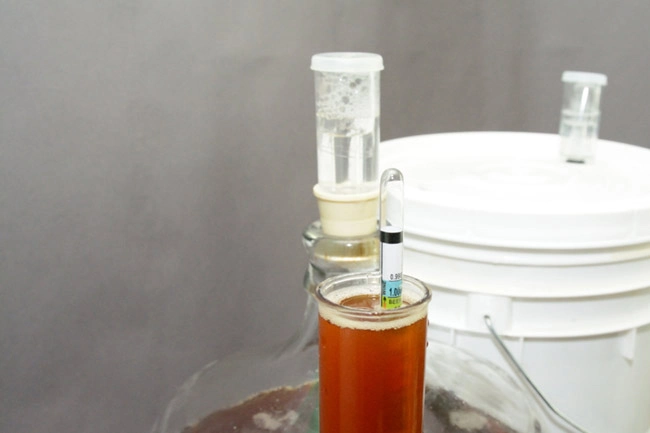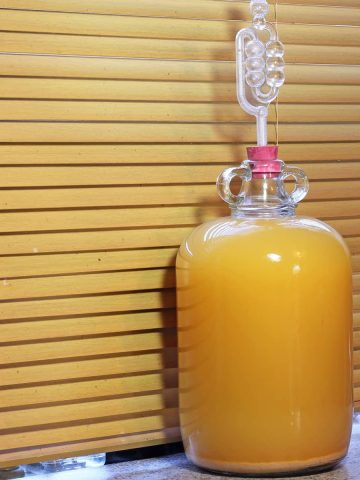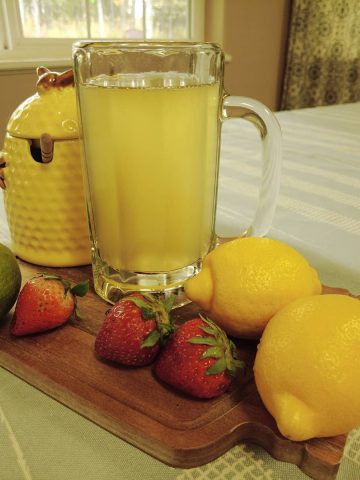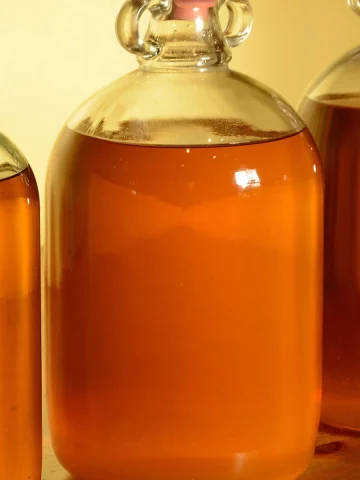Recommended Equipment for Making Mead & Ingredients
Making your first batch of Honey Mead, beer, or wine at home is tons of fun. And although crafting world-class drinks is an art form and needs practice, you need not be an expert to start brewing.
You do need the right mead equipment, but that's why we're here.
Home mead-making kits and home brewing supplies can be as complex and sophisticated as you want, but you only need ten essential items to start.
Here is a complete list of the necessary equipment to brew traditional meads, a.k.a. honey wine, beer, and many other exciting drinks.
Primary Fermentation Vessel
The magic happens in a primary fermentation vessel when making fermented drinks like mead. You'll pour the honey, water, and yeast in to let the microbes do all the work for you; they'll turn the sugar into alcohol. It helps to have two, so you can siphon the mead into a clean container for secondary fermentation.
You can use a plastic 5-gallon bucket or a 5-gallon carboy; either will do fine.
Last update on 2025-05-23 / Affiliate links / Images from Amazon Product Advertising API
DIY Mead Equipment
If you have the tools to drill a hole in a bucket for an airlock and spigot, I suggest running out to Home Depot and buying a food-grade bucket for around $10 - $12.
While you are there, pick up two extra buckets, one to mix honey and water in and another to sanitize equipment in.
While this route will offer a more affordable price, it does take up a little more time.
Besides buying the bucket, you will need a lid, stopper, airlock, and a spigot.
Airlocks
This exciting gadget is essential for fermenting beverages. An airlock is a one-way valve that keeps the fermented liquid safe from oxygen and contaminants while allowing the carbon dioxide building up in the fermenter to escape slowly.
If just a bit of oxygen comes in contact with your fermenting drink, it will oxidize it and allow other nasty microbes to thrive, some of which can turn your brew into vinegar.
On the other hand, allowing the CO2 to escape will prevent your fermenter from bursting open. A suitable airlock is durable plastic and has two small chambers to fill with water. Airlocks are fun when they start getting all bubbly.
Stoppers
A rubber stopper with a tiny hole is the perfect closure to seal a fermenter. What's the hole for? For the airlock, of course. You can also fit in a rubber tube once ready to pump out your fermented drink, but we'll talk about that one second.
Rubber stoppers are inexpensive but vital. No other stopper will do. Regarding fermentation, you need a tight seal with plenty of versatility to fit airlocks and tubbing.
Plastic Bottling Spigot
The spigot will help minimize the uptake as you rack after fermentation. Using this as a bottling bucket, simply rotate the spigot to maximize product output. The spigot is an excellent bottle filler tool that makes the process easier.
Auto-Siphon and Tubbing
The auto siphon is an optional piece of equipment but highly recommended if you want to do things quickly and without a lot of mess.
If you use a bucket or carboy without a spigot, you will want a racking cane, a.k.a. auto-siphon, to move the mead from one container to another.
An auto-siphon pump and rubber tubbing are perfect, especially with handy hose clamps. Use it to bottle the mead cleanly and efficiently.
You’ll be glad you have this one around.
Last update on 2025-05-23 / Affiliate links / Images from Amazon Product Advertising API
Star San Sanitizer
Star San is the industry standard for both homebrewed drinks and industrial beverages. The world-class foaming sanitizer will eliminate harmful microorganisms in your kettle, fermenter, or tubes.
Make sure you sterilize all your equipment before starting and clean everything again after using.
The difference between a great fermented drink and a funky one is the hygiene throughout the fermentation process.
Every piece of equipment must be squeaky clean before you start fermenting, and for that, you need a sanitizer that won't affect your brew in any way.
No products found.
Hydrometer
Here's where things get a bit technical but fear not. A hydrometer is a precision tool that measures a liquid's density. In other words, it tells you how much sugar (and alcohol) you have in a fermenting beverage.
You'll use the hydrometer before, during, and after fermentation to know exactly what's happening.
Related Topic: How To Cold Crash Mead
A good hydrometer comes with a glass test jar, a hydrometer that looks like a wacky thermometer, and a brush to clean your equipment after use. Without a hydrometer, you have no clue how fermentation is going, so get a good one.
Last update on 2025-05-23 / Affiliate links / Images from Amazon Product Advertising API
Top Bottles, Corks & Caps
Not having suitable bottles and corks to store your fermented drink once the process is finished is a classic mistake.
Somehow, everyone misses that one. You can easily save a lot of money by using your beer and wine bottles. Any clean and sterilized wine bottles can be reused for bottling mead.
Wine corks are classic stoppers that never disappoint, but crown caps and other closures are also popular.
Choose your favorite bottle and find the right stopper for it. Wine corks and caps are more than closures; they also give personality to your final product.
And don't forget a bottle capper.
Last update on 2025-05-23 / Affiliate links / Images from Amazon Product Advertising API
Additional Equipment for Brewing Honey Mead
The following items are helpful but not required to make a tasty mead.
A long-handled spoon will make it easier to stir the honey at the bottom of a bucket or carboy.
Long Cleaning Brush for cleaning a carboy.
Best Mead Making Kits
There are many different kits to choose from when it comes to homebrewing. Here are my top three favorite beer-making kits that include everything you need to start your mead maker journey.
Last update on 2025-05-23 / Affiliate links / Images from Amazon Product Advertising API
Simple Mead Making Ingredients
Raw Honey
2 -3 lbs of Raw Unprocessed Honey
- Honey as it should be raw, natural, and pure
- Perfectly delicious wildflower honey, with absolutely no artificial colors, flavors, or additives
- Uncooked, unpasteurized, and unaltered. Certified Kosher.
- Always responsibly harvested from healthy Texas bees
- Free of chemicals, additives, antibiotics, pesticides, herbicides, and pollutants
Last update on 2025-05-24 / Affiliate links / Images from Amazon Product Advertising API
Wine Yeast
The yeast can substantially affect the finished mead, and you want to choose a yeast with a high enough alcohol tolerance to ferment the honey fully. An excellent place to start is the Lavin-D47, and if you'd like to get more into it, you can read this article on choosing the best yeast for mead.
Whether making wine, beer, or cider, you can always rely on an old friend, yeast. These microorganisms, actually unicellular fungi, love eating sugar and turning it into alcohol.
There are different commercial yeasts, each better adapted to distinct projects. Whether you're making fruit wine or kombucha, the microorganism for each project might be slightly different.
Did you know the yeast used to make fermented spirits is the same species used to raise bread dough? The tiny buddy is Saccharomyces cerevisiae, and it can turn any sugary liquid into alcohol within days.
Yeast Nutrients and Yeast Energizers in Mead Making
Honey is a nutrient-poor food source. It lacks some of the necessary compounds and elements that yeast needs. What this means for mead-making is that if you try to ferment honey and water alone, the yeast will often become stressed and can stop fermenting too soon and start producing undesirable off-flavors.
Although yeast nutrients and/or yeast energizers are optional additives. I think a few micronutrients helping them along in the process is a good idea. Honey is a complex sugar, and it’s harder for the yeast to metabolize than refined sugar or fruit sugar. So why not give them a little help.
Adding a Yeast Nutrient and Yeast Energizer is an excellent supplement that will supply everything the yeast needs to ferment successfully and stay healthy.
Potassium sorbate for Backsweeten
You will need some potassium sorbate if you plan to back-sweeten the mead. Adding a tiny amount of potassium sorbate (½ teaspoon) per gallon of mead will halt the fermentation.
Potassium sorbate does not kill the yeast but prevents them from converting more sugars into carbon dioxide and alcohol.
Learn more about Campden tablets.
Did I cover all you wanted to know about mead equipment and ingredients?
This article looked at all the equipment needed to start with mead-making.
We examined not only what is required but also included a few extras.
But primarily focused on answering what equipment is needed to make honey mead at home.
Also, if you are ready to make mead, please try our easy one-gallon honey mead recipe, Strawberry Mead recipe, and Apple cyser recipe.
Cheers!








![AYL Flip Top Glass Bottle [1 Liter / 33 fl. oz.] [Pack of 4] – Swing Brewing Bottle with Stopper for Beverages, Oil, Vinegar, Kombucha, Water, Soda, Kefir – Airtight Lid & Leak Proof Cap – Clear](https://m.media-amazon.com/images/I/41AVRAbPYVL.jpg)









